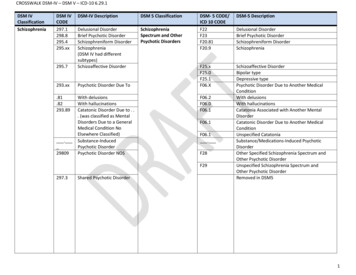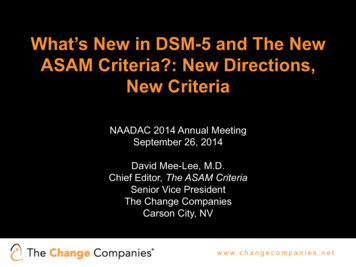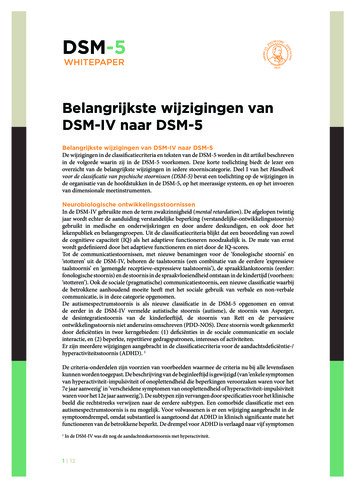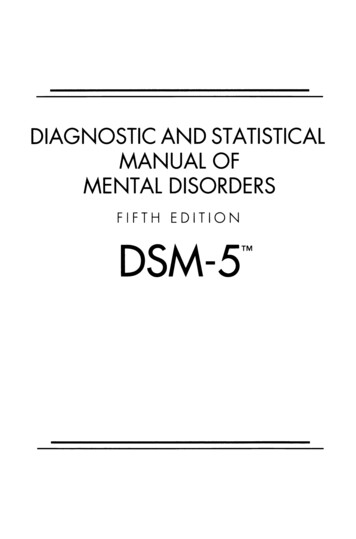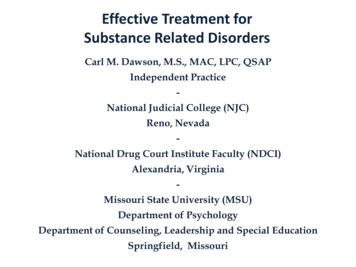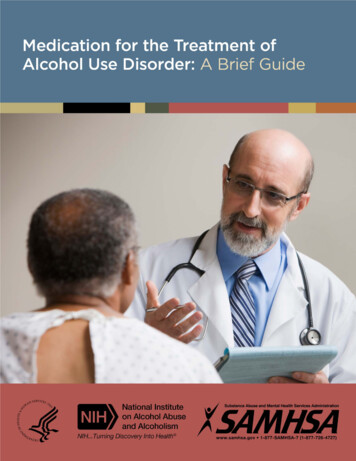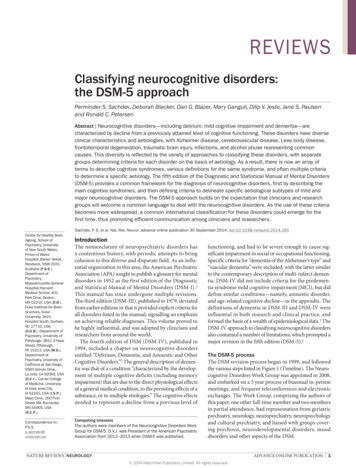
Transcription
REVIEWSClassifying neurocognitive disorders:the DSM‑5 approachPerminder S. Sachdev, Deborah Blacker, Dan G. Blazer, Mary Ganguli, Dilip V. Jeste, Jane S. Paulsenand Ronald C. PetersenAbstract Neurocognitive disorders—including delirium, mild cognitive impairment and dementia—arecharacterized by decline from a previously attained level of cognitive functioning. These disorders have diverseclinical characteristics and aetiologies, with Alzheimer disease, cerebrovascular disease, Lewy body disease,frontotemporal degeneration, traumatic brain injury, infections, and alcohol abuse representing commoncauses. This diversity is reflected by the variety of approaches to classifying these disorders, with separategroups determining criteria for each disorder on the basis of aetiology. As a result, there is now an array ofterms to describe cognitive syndromes, various definitions for the same syndrome, and often multiple criteriato determine a specific aetiology. The fifth edition of the Diagnostic and Statistical Manual of Mental Disorders(DSM‑5) provides a common framework for the diagnosis of neurocognitive disorders, first by describing themain cognitive syndromes, and then defining criteria to delineate specific aetiological subtypes of mild andmajor neurocognitive disorders. The DSM‑5 approach builds on the expectation that clinicians and researchgroups will welcome a common language to deal with the neurocognitive disorders. As the use of these criteriabecomes more widespread, a common international classification for these disorders could emerge for thefirst time, thus promoting efficient communication among clinicians and researchers.Sachdev, P. S. et al. Nat. Rev. Neurol. advance online publication 30 September 2014; doi:10.1038/nrneurol.2014.181Centre for Healthy BrainAgeing, School ofPsychiatry, Universityof New South Wales,Prince of WalesHospital, Barker Street,Randwick, NSW 2031,Australia (P.S.S.).Department ofPsychiatry,Massachusetts GeneralHospital/HarvardMedical School, 401Park Drive, Boston,MA 02215, USA (D.B.).Duke Institute for BrainSciences, DukeUniversity, 3521Hospital South, Durham,NC 27710, USA(D.G.B.). Department ofPsychiatry, University ofPittsburgh, 3811 O’HaraStreet, Pittsburgh,PA 15213, USA (M.G.).Department ofPsychiatry, University ofCalifornia at San Diego,9500 Gilman Drive,La Jolla, CA 92093, USA(D.V.J.). Carver Collegeof Medicine, Universityof Iowa, Iowa City,IA 52242, USA (J.S.P.).Mayo Clinic, 200 FirstStreet SW, Rochester,MN 55905, USA(R.C.P.).Correspondence to:P.S.S.p.sachdev@unsw.edu.auIntroductionThe nomenclature of neuropsychiatric disorders hasa contentious history, with periodic attempts to bringcohesion to this diverse and disparate field. As an influ‑ential organization in this area, the American PsychiatricAssociation (APA) sought to publish a glossary for mentaldisorders in 1952 as the first edition of the Diagnosticand Statistical Manual of Mental Disorders (DSM‑I).1This manual has since undergone multiple revisions.The third edition (DSM‑III), published in 1979, deviatedfrom earlier editions in that it provided explicit criteria forall disorders listed in the manual, signalling an emphasison achieving reliable diagnoses. This volume proved tobe highly influential, and was adopted by clinicians andresearchers from around the world.The fourth edition of DSM (DSM‑IV), published in1994, included a chapter on neurocognitive dis ordersentitled “Delirium, Dementia, and Amnestic and OtherCognitive Disorders.”2 The general description of demen‑tia was that of a condition “characterized by the develop‑ment of multiple cognitive deficits (including memoryimpairment) that are due to the direct physio logical effectsof a general medical condition, to the persisting effects of asubstance, or to multiple etiologies.” The cognitive effectsneeded to represent a decline from a previous level ofCompeting interestsThe authors were members of the Neurocognitive Disorders WorkGroup for DSM‑5. D.V.J. was President of the American PsychiatricAssociation from 2012–2013 when DSM‑5 was published.functioning, and had to be severe enough to cause sig‑nificant impairment in social or occupational functioning.Specific criteria for “dementia of the Alzheimer’s type” and“vascular dementia” were included, with the latter similarto the contemporary description of multi-infarct demen‑tia. DSM‑IV did not include criteria for the predemen‑tia syndrome mild cognitive impairment (MCI), but diddefine similar conditions—namely, amnestic disorder,and age-related cognitive decline—in the appendix. Thedefinitions of dementia in DSM‑III and DSM‑IV wereinfluential in both research and clinical practice, andformed the basis of a wealth of epidemio logical data.3 TheDSM‑IV approach to classifying neurocognitive disordersalso contained a number of limitations, which prompted amajor revision in the fifth edition (DSM‑5).4The DSM‑5 processThe DSM revision process began in 1999, and followedthe various steps listed in Figure 1 (Timeline). The Neuro cognitive Disorders Work Group was appointed in 2008,and embarked on a 5 year process of biannual in-personmeetings, and frequent teleconferences and electronicexchanges. The Work Group, comprising the authors ofthis paper, one other full-time member and two membersin partial attendance, had representation from geriatricpsychiatry, neurology, neuropsychiatry, neuropsychologyand cultural psychiatry, and liaised with groups cover‑ing psychosis, neurodevelopmental disorders, mood disorders and other aspects of the DSM.NATURE REVIEWS NEUROLOGYADVANCE ONLINE PUBLICATION 1 2014 Macmillan Publishers Limited. All rights reserved
REVIEWSKey points The fifth edition of the Diagnostic and Statistical Manual of Mental Disorders(DSM‑5) provides a framework for the diagnosis of neurocognitive disordersbased on three syndromes: delirium, mild neurocognitive disorder and majorneurocognitive disorder Major neurocognitive disorder is mostly synonymous with dementia, althoughthe criteria have been modified so that impairments in learning and memoryare not necessary for diagnosis DSM‑5 describes criteria to delineate specific aetiological subtypes of mildand major neurocognitive disorder The diagnostic certainty of an aetiological diagnosis is based on clinicalfeatures and biomarkers, and can be qualified as probable or possible The DSM‑5 criteria are consistent with those developed by various expertgroups for the different aetiological subtypes of neurocognitive disorders Further validation in clinical practice is necessary, but we expect thesecriteria will have high reliability and validity, and widespread adoption will bringconsistency to the diagnosis of diverse neurocognitive disordersThe Neurocognitive Disorders Work Group formallyinvited additional experts to act as external ad visers,and informally consulted with other such experts inter nationally. Public comment was solicited on draft criteriaposted on the DSM‑5 website. Although the administra‑tive procedures determined by the DSM-5 Task Force— comprising 31 leading experts in psychiatric research andpractice, including the chairs of the 13 Work Groups—hadto be followed, no intellectual constraints were imposedon the Work Group. The tasks of literature review andexternal liaison were shared by the Work Group members.The final criteria, designed to reflect the latest advancesin scientific knowledge in this field, were reached byconsensus of the members after considerable input fromexpert advisers. The final cri teria were reviewed by severaloverarching DSM‑5 panels, including a scientific reviewcommittee, a clinical and public health review committee,the Task Force, and a summit body, before final approvalwas granted by the APA Board of Trustees.5The purpose of DSM-5As the official classification system of the APA, the pri mary constituency of the DSM is mental health profes‑sionals based in the USA, who use it primarily for thepurpose of diagnosing their patients and billing for theirservices. The DSM is also used extensively by psychiat‑ric researchers for participant selection criteria, outcomemeasures and reliable communication of their work.The use of DSM, however, transcends professional andnational boundaries, with widespread use by cliniciansand researchers in a variety of settings internationally.The DSM‑5 has received a chorus of criticism from manyquarters, largely owing to its inability to meet all needs andexpectations of a diverse group of users.6 Most of this criti‑cism is not related to the neurocognitive disorders cluster,but a few contentious aspects will be discussed below.This Review presents an introduction to the DSM‑5approach of classifying the neurocognitive disorders.We cover the three major cognitive syndromes that formthe basis of the neurocognitive disorders cluster, includ‑ing the rationale for grouping these disorders togetherand the key criteria for each diagnosis. We also describeseveral aetiological subtypes of minor and major neuro cognitive disorder, which replace DSM‑IV diagnoses suchas dementia of the Alzheimer type and dementia due toParkinson disease.The neurocognitive disorders clusterIn line with the descriptive approach to classificationused in DSM‑5, the cluster of neurocognitive disordersis charac terised by the presence of cognitive deficits thatare the most prominent and defining features of a givencondition. Whereas cognitive impairment is present inmany mental disorders—such as schizophrenia, bipolardis order, major depression and obsessive compul sive disorder —it cannot be regarded as the defining featureof these disorders as it might be, for example, in Alzheimerdisease (AD) or traumatic brain injury. The term ‘cogni‑tive’ is used broadly in psychology to refer to thought andmultiple related processes,7 and the term ‘neurocognitive’was applied to this cluster of disorders to emphasize thatdisrupted neural substrates lead to symptoms, and that, inmost cases, such disruption can be reliably meas ured.8 Thedisorders in the neurocognitive cluster are also charac terized by ‘acquired’ deficits, which represent a declinefrom a previously attained level of functioning, and arenot n eurodevelopmental deficits present from birth orearly life.When referring to neurocognitive disorders, it isimpor tant to delineate the domains of cognitive func‑tion that are likely to be affected. Cognitive domainshave been variously categorized by different authors,9,10and a complete consensus is lacking. For the purpose ofclassifying neurocognitive disorders, the NeurocognitiveWork Group agreed on six principal domains of cogni‑tive f unction—complex attention, executive function,learning and memory, language, perceptual–motorfunction, and social cognition (Figure 2)—each with sub domains. The DSM‑5 provides examples of symptomsand observations for each domain, and of ways to objec‑tively assess each domain, but avoids the endorsement ofproprietary tests.The newly included domain of social cognition is par‑ticularly noteworthy, as it recognizes the fact that, in someneurocognitive disorders, socially inappropriate behav‑iour can manifest as a salient feature. These symptomscan take the form of reduced ability to inhibit unwantedbehaviour, recognize social cues, read facial expressions,express empathy, motivate oneself, alter behaviour inresponse to feedback, or develop insight. Deficits in socialcognition were usually referred to as personality changein previous diagnostic criteria.2Subdividing the clusterThe neurocognitive disorders cluster comprises threesyndromes, each with a range of possible aetiologies:delirium, mild neurocognitive disorder and major neurocognitive disorder.DeliriumThis neurocognitive disorder is characterised by distur‑bance in attention that makes it difficult for the indi vidual2 ADVANCE ONLINE PUBLICATION www.nature.com/nrneurol 2014 Macmillan Publishers Limited. All rights reserved
REVIEWSAPA launches evaluationof DSM-IV28 Task Force membersappointed)The Neurocognitive Work Groupcomprised 10 members: the authorsof this paper plus I. Grant, W. Faison(2007–2008) and E. J. LenzeAPA appoints chairsof Task Force1999200313 working groups appointed200620072008Periodic in-person meetingsand teleconferences forthe next 5 years, withexternal expert advisorsoccasionally invited20102011Draft criteria posted onAPA website for professionaland public comment13 international DSM-5 planningconferences (with WHO)Revisions and field trialsPublicationof DSM-520122013Final draft criteria submitted toScientific Review Committee andrevised primary feedbackHarmonization of codeswith ICD-10Figure 1 Timeline of the DSM-5 consultation and revision process. Abbreviations: APA, American Psychiatric Association;DSM, Diagnostic and Statistical Manual of Mental Disorders; ICD-10, International Classification of Diseases 10 th edition.to direct, sustain and shift their focus. The individual is,therefore, likely to have reduced orientation to theirenvironment, and at times to oneself. This symptomhas sometimes been referred to as ‘reduced level ofconscious ness’ or confusional state,11 although distur‑bance in awareness is a more accurate description. Thedisturb ance of awareness tends to develop over hours todays, and typically fluctuates in the course of the day,often worsening in the evening. Delirium can be causedby an underlying medical condition, substance intoxica‑tion or withdrawal, exposure to toxins, or a combinationof these factors. Patients may be hyperactive, hypoactiveor have a mixed level of activity. The criteria for deliriumare listed in Box 1.Mild and major neurocognitive disorderIn this broad category of neurocognitive disorders, thereis clear decline from a previous level of functioning inone or more of the key cognitive domains (Figure 2).Attention may be disturbed in these disorders, but, incontrast to delirium, this disturbance is not the corePerceptual–motor functionVisual �motorcoordinationExecutive functionPlanningDecision-makingWorking memoryResponding to feedbackInhibitionFlexibilityComplex attentionSustained attentionDivided attentionSelective attentionProcessing speedLanguageObject namingWord findingFluencyGrammar and syntaxReceptive languageNeurocognitivedomainsLearning and memoryFree recallCued recallRecognition memorySemantic and autobiographicallong-term memoryImplicit learningSocial cognitionRecognition of emotionsTheory of mindInsightFigure 2 Neurocognitive domains. The DSM‑5 defines six key domains ofcognitive function, and each of these has subdomains. Identifying the domains andsubdomains affected in a particular patient can help establish the aetiology andseverity of the neurocognitive disorder. Objective assessments are essential, butthe DSM‑5 does not name any proprietary tests. Abbreviation: DSM‑5, Diagnosticand Statistical Manual of Mental Disorders 5th edition.feature, and awareness of the environment is gener‑ally retained, except in very severely impaired patients.There fore, the diagnoses of mild or major neuro cognitivedisorder are not made if the cognitive deficits occur in thecontext of persistent delirium, but can be made in patientsfor whom delirium manifests and then resolves.Mild neurocognitive disorder is a new addition to theDSM nomenclature, previously subsumed by the non‑specific category of ‘cognitive disorder not otherwisespecified,’ and represents a new framework for the com‑monly used diagnosis of MCI.12 Major neurocognitivedisorder mostly obviates the older concept of dementia,even though DSM‑5 retains ‘dementia’ in parenthesesto indicate that it may still be used (discussed furtherbelow). Mild and major neurocognitive disorders are cat‑egorical diagnostic constructs imposed on an underlyingcontinuum of cognitive impairment from normality tosevere impairment, as seen in the clinic and the popula‑tion. Therefore, the structure of the DSM‑5 criteria formild neurocognitive disorder is parallel to that for majorneurocognitive disorder, with the differences being theseverity of cognitive deficits and functional impairment.DSM‑5 does not permit the diagnosis of mild or majorneurocognitive disorders if the cognitive deficits can bebetter explained by another mental disorder, such asmajor depression or schizophrenia. This approach hasbeen criticised by some commentators,22 who arguethat distinct neurocognitive disorders can be caused bymental disorders such as major depression, as implicit inthe con cept of depressive dementia. Under this frame‑work, these neurocognitive disorders would be regardedas aetio l ogical subtypes rather than as confoundingfactors. The argument in favour of the DSM‑5 approachis that neuro cognitive disorders are only diagnosed forconditions that have cognitive deficits as the core ordefining feature: though psychiatric disorders should beconsidered in the differential diagnosis of neurocognitivedisorders, distinct conditions should not be conflated.Mild neurocognitive disorderThe use of the diagnosis of MCI has become common‑place in clinical practice, partly because many patientswith cognitive decline now seek treatment earlier in thecourse of the disease, before a diagnosis of dementia isNATURE REVIEWS NEUROLOGYADVANCE ONLINE PUBLICATION 3 2014 Macmillan Publishers Limited. All rights reserved
REVIEWSBox 1 Diagnostic criteria for deliriumA. A disturbance in attention (that is, reduced ability to direct, focus, sustain, andshift attention) and awareness (reduced orientation to the environment).B. The disturbance develops over a short period of time (usually hours to a fewdays), represents a change from baseline attention and awareness, and tendsto fluctuate in severity during the course of a day.C. An additional disturbance in cognition (for example, memory deficit,disorientation, language, visuospatial ability, or perception).D. The disturbances in Criteria A and C are not better explained by another preexisting, established, or evolving neurocognitive disorder and do not occur inthe context of a severely reduced level of arousal, such as coma.E. There is evidence from the history, physical examination, or laboratory findingsthat the disturbance is a direct physiological consequence of another medicalcondition, substance intoxication or withdrawal (that is, due to a drug of abuseor to a medication), or exposure to a toxin, or is due to multiple aetiologies.Specify whether: Substance intoxication delirium Substance withdrawal delirium Medication-induced delirium Delirium due to another medical condition Delirium due to multiple aetiologies: Specify if: acute (lasting a few hours or days); persistent (lasting weeksor months) Specify if: hyperactive, hypoactive, mixed level of activityReprinted with permission from the Diagnostic and Statistical Manual of Mental Disorders,Fifth Edition, (Copyright 2013). American Psychiatric Association. All Rights Reserved.Box 2 Diagnostic criteria for mild neurocognitive disorderA. Evidence of modest cognitive decline from a previous level of performance inone or more cognitive domains (complex attention, executive function, learningand memory, language, perceptual–motor, or social cognition) based on:1. Concern of the individual, a knowledgeable informant, or the clinician thatthere has been a mild decline in cognitive function; and2. A modest impairment in cognitive performance, preferably documentedby standardized neuropsychological testing or, in its absence, anotherquantified clinical assessment.B. The cognitive deficits do not interfere with capacity for independence ineveryday activities (that is, complex instrumental activities of daily living suchas paying bills or managing medications are preserved, but greater effort,compensatory strategies, or accommodation may be required).C. The cognitive deficits do not occur exclusively in the context of a delirium.D. The cognitive deficits are not better explained by another mental disorder(for example, major depressive disorder or schizophrenia).Reprinted with permission from the Diagnostic and Statistical Manual of Mental Disorders,Fifth Edition, (Copyright 2013). American Psychiatric Association. All Rights Reserved.justified. Furthermore, many brain diseases result in cog‑nitive impairments that may not meet the threshold offunctional impairment specified by the DSM-IV demen‑tia diagnosis, but nonetheless have implications for theindividual and those around them.The move to diagnose neurocognitive disorders as earlyas possible emerged from the recognition of a long pre‑dementia stage in neurodegenerative diseases, improve‑ments in early diagnosis, and the increasing emphasison early intervention to prevent or postpone dementia.Importantly, mild neurocognitive disorder is not always aprecursor of major neurocognitive disorder, and the diag‑nosis has no requirement for further decline: there may becontinued decline, as in the neurodegenerative disorders,or the impairment may be static, as in traumatic braininjury. The introduction of mild neurocognitive disor‑der has been criticized on the grounds that it medicalizesnormality and might lead to many ‘worried well’ indi‑viduals with no disease being wrongly diagnosed, leadingto unnecessary diagnostic tests and unproven treat‑ments.16 However, such criticism should not preclude the appropriate use of this diagnosis in the clinic.The criteria for mild neurocognitive disorder are pre‑sented in Box 2. DSM‑5 describes the level of cognitivedecline in mild neurocognitive disorder to be “modest,”leaving it up to the diagnostician to make the final judge‑ment on the severity. As a guideline, test performance inmild neurocognitive disorder should fall in the range of1–2 SD below the normative mean, or between the thirdand 16th percentiles, on tests for which appropriate normsare available. The DSM‑5 does not specify which tests, orhow many, should be administered per cognitive domain.In the absence of a formal neuropsychological assess‑ment, the clinician may rely on ‘bedside’ assessments,but the objective demonstration of cognitive deficits isessential. In fact, because mild neurocognitive disorderneeds to be distinguished from both normal cognitiveageing and major neurocognitive disorder (or dementia),even greater reliance on neuropsychological assessmentis called for in mild than in major neurocognitive dis order. Serial assessments might be necessary to documentdecline, but the results must be interpreted cautiously inview of practice effects, variable test–retest reliability, andthe dearth of normative data on cognitive decline.21The DSM‑5 criteria for mild neurocognitive dis‑order must be considered in the context of the othercommonly used criteria for MCI: the Mayo Criteria,16the International Working Group (IWG) or the KeySymposium Criteria18,19 and the National Institute ofAging–Alzheimer’s Association (NIA–AA) Criteria.20The Mayo Criteria correspond best to what is referredto as amnestic MCI in the IWG Criteria, with the mainobjective of the diagnosis being the identification of AD atthe predementia stage.12 NIA–AA criteria were explicitlydeveloped to enable researchers to diagnose MCI due toAD, but include a generic definition of MCI. The DSM‑5criteria for mild neurocognitive disorder are conceptuallysimilar to both the NIA–AA and IWG criteria, requir‑ing decline in one or more cognitive domains, with orwithout memory impairment.The cognitive deficits in mild neurocognitive disorderdo not interfere with the capacity for independence ineveryday activities. Rather, the individual usually func‑tions at a suboptimal level, with everyday tasks becomingmore effortful owing to the engagement of compensatorystrategies to maintain independence. The criterion ofindependent functioning represents the key distinctionbetween the mild and major neurocognitive disorders,and relies on an insightful report by the individual and/or a family member, and a level of good judgement fromthe clinician.Major neurocognitive disorderThe introduction of major neurocognitive disorder as analternative term to dementia in DSM‑5 was prompted bya number of reasons. Although we accept the long historyof dementia in clinical medicine, as well as its familiarity4 ADVANCE ONLINE PUBLICATION www.nature.com/nrneurol 2014 Macmillan Publishers Limited. All rights reserved
REVIEWSA. Evidence of significant cognitive decline from a previous level of performance inone or more cognitive domains (complex attention, executive function, learningand memory, language, perceptual–motor, or social cognition) based on:1. Concern of the individual, a knowledgeable informant, or the clinician thatthere has been a significant decline in cognitive function; and2. A substantial impairment in cognitive performance, preferably documentedby standardized neuropsychological testing or, in its absence, anotherquantified clinical assessment.B. The cognitive deficits interfere with independence in everyday activities (thatis, at a minimum, requiring assistance with complex instrumental activities ofdaily living such as paying bills or managing medications).C. The cognitive deficits do not occur exclusively in the context of a delirium.D. The cognitive deficits are not better explained by another mental disorder.Specify: Without behavioural disturbance: if the cognitive disturbance is notaccompanied by any clinically significant behavioural disturbance With behavioural disturbance (specify disturbance): if the cognitivedisturbance is accompanied by a clinically significant behaviouraldisturbance (for example, psychotic symptoms, mood disturbance, agitation,apathy, or other behavioural symptoms). For example, major depressivedisorder or schizophreniaknows the individual, and also on the demonstrationof substantially impaired performance on an objec‑tive cognitive measure. A cognitive concern might notbe voiced spontaneously, and might need to be elicitedby careful questioning of the patient and/or significantothers. The requirement of an objective measure is bestmet by formal neuropsychological assessment, with theperformance being compared to normative data appro‑priate for the patient’s age, educational attainment andcultural–linguistic background. If such an assessmentis available, the performance typically falls at least 2 SDbelow the normative mean (or below the third percen‑tile) on the test administered. As in mild neurocognitivedisorder, patients for whom neuro psycho logical testingis not feasible, or appropriate norms are not available,can undergo a brief bedside assessment by the clinicianto supply the objective data necessary for diagnosis.Competent interpretation of test performance is essen‑tial, and can be aided by prior administration of the sametest so that decline can be assessed.Reprinted with permission from the Diagnostic and Statistical Manual of Mental Disorders,Fifth Edition, (Copyright 2013). American Psychiatric Association. All Rights Reserved.Aetiological subtypesBox 3 Diagnostic criteria for major neurocognitive disorder (or dementia)to the laity and policy makers, the limitations of thisterm should be recognized.13 The term dementia is mostcommonly used to refer to older individuals— very oftensynonymously with AD—and is less likely to be used todescribe younger people with severe cognitive deficits dueto, for example, traumatic brain injury or HIV infection.The term has also acquired a pejorative connotation, andalthough a mere change in terminology is not sufficientto eliminate stigma, it might be a necessary first step. Weexpect that ‘dementia’ will continue to be used for elderlypatients and in many clinical settings owing to familiarityand historical continuity, but we also expect that majorneurocognitive disorder will be a more suitable diagnosisfor many younger patients.The DSM‑5 criteria for major neurocognitive dis order(Box 3) have some noteworthy differences from theDSM-IV criteria for dementia. First, substantial decline inonly one cognitive domain is sufficient for the diagnosis ifthe other criteria are met. As a consequence, the DSM-IVcategory of ‘amnestic disorder’ is now covered by majorneurocognitive disorder. Second, memory impairment isnot essential for the diagnosis. This change was made inrecognition of the fact that many individuals with demen‑tia not due to AD can have relatively intact memory, asis seen in patients with cerebro vascular disease,14 fronto temporal degeneration15 and some other conditions.Third, the functional cri terion has been revised to reflectthat the threshold for diagnosis of major neuro cognitivedisorder emphasizes loss of independence in daily living,in comparison with the DSM-IV requirement of impair‑ment that “significantly interferes with work or socialactivities or r elationships with others.”The determination of “significant” cognitive decline—that is, impairment sufficient to diagnose major neuro cognitive disorder—is based on concern expressedby an individual or by an informant or clinician whoThe DSM‑5 classification was designed to complementthe clinical process in which a diagnosis is made in twosteps: a syndromal diagnosis is made first, and thenpotential causative factors are examined to attributeaetiology. Mild and major neurocognitive disorders aretherefore subtyped according to aetiology.In many patients with neurocognitive disorders, thereis evidence for a causative disorder such as Parkinsondis ease, Huntington disease, traumatic brain injury, HIVinfection or AIDS, or stroke. In other patients, the cog‑nitive and behavioural symptoms manifest first, and thelongi tudinal course reveals aetiologies such as in AD,cerebro vascular disease, frontotemporal lobar degenera‑tion and Lewy body disease. Occasionally, and especi ally in older individuals, there can be multiple causativefactors, all of which should be recognized, but withprimacy or salience assigned t
formed the basis of a wealth of epidemio logical data. 3 The DSM‑IV approach to classifying neurocognitive disorders also contained a number of limitations, which prompted a major revision in the fifth edition (DSM‑5). 4 The DSM‑5 process The DSM revision process began in 1999, and followed the various steps listed in Figure 1 (Timeline).
